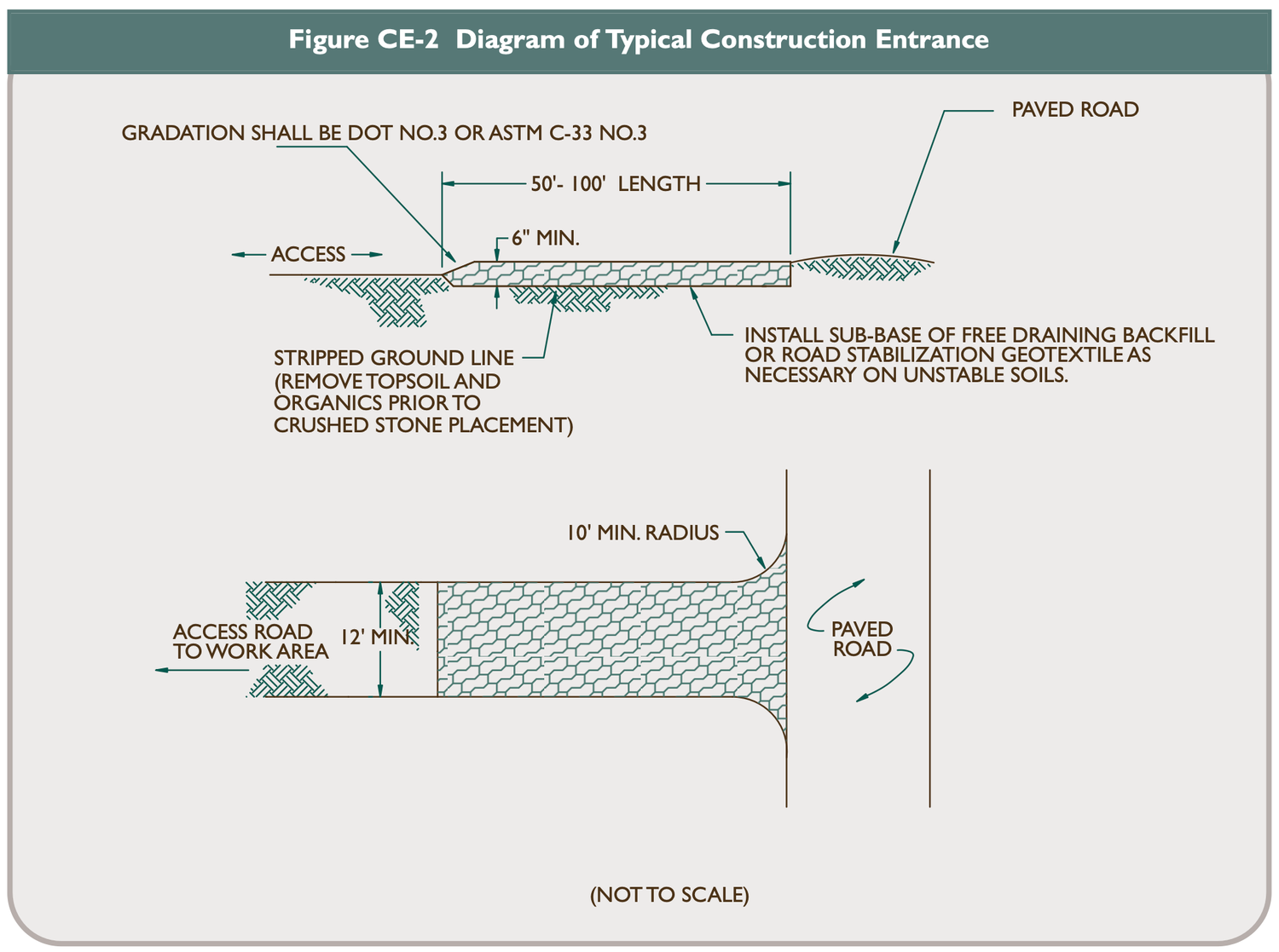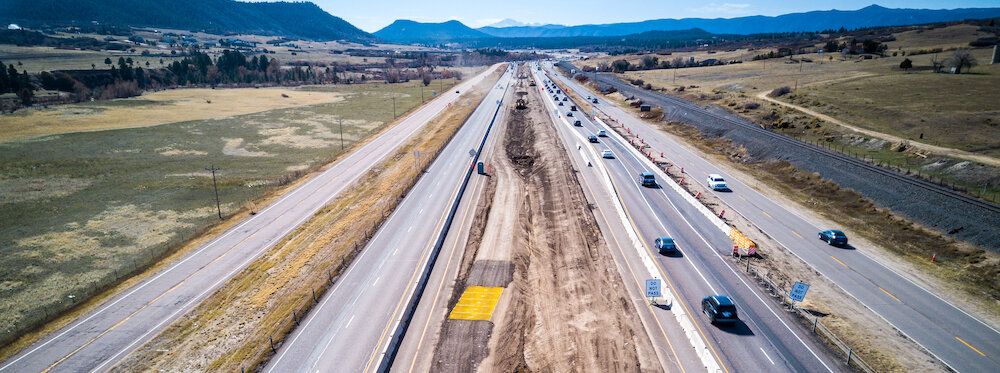Connecticut Construction Entrance Detail
Connecticut owes its name—and much of its identity—to the Connecticut River, a waterway that defines the landscape and supports nearly every aspect of life in the state. Stretching 406 miles with a watershed of more than 11,000 square miles, the river accounts for roughly 70% of the freshwater flowing into Long Island Sound. Its health and purity are vital to both residents, businesses, and wildlife, and maintaining that balance is a shared responsibility among residents, communities, industries, and contractors across the state.
From the New England colonial towns along the river valley to the bustling modern hubs of Hartford, Greenwich, and New Haven, Connecticut’s population and economy remain tied to clean water. But with development and growth comes the need to control pollution especially sediment and mud carried from construction sites into storm drains and waterways. That’s where Best Management Practices (BMPs) such as stabilized construction entrances play a critical role in stormwater management and environmental protection.
The Importance of Clean Water and the Connecticut River
The Connecticut River is the longest in New England and one of the most historically significant in the United States. Its extensive shoreline collects stormwater runoff from across the region, channeling it toward the Sound. Because the watershed is so vast, even small sources of pollution like sediment tracked onto public roads from construction sites can have significant downstream impacts.
For much of the 20th century, industrial and construction pollutants degraded water quality in the river. Sediment, oils, and heavy metals found their way into storm drains, threatening and harming the delicate ecosystems that rely on these waters. Today, the river is home to many species such as rainbow trout, pike, eels, and several mussel species eight of which are considered endangered by the Environmental Protection Agency (EPA).
Thanks to the Water Quality Act passed in 1965, the state has made tremendous measurable progress in restoring the river’s health. Most stretches are now safe for fishing, boating, and recreation, but continued vigilance is essential. Connecticut’s environmental policies focus heavily on preventing new sources of pollution through careful management and regulation of stormwater from construction and industrial sites.
The Connecticut DEPARTMENT OF ENERGY AND ENVIRONMENTAL PROTECTION (DEEP)
The federal Clean Water Act established the National Pollutant Discharge Elimination System (NPDES) to regulate pollutants entering U.S. waters. In Connecticut, the NPDES program is administered by the Department of Energy and Environmental Protection (DEEP), which oversees stormwater permits and ensures compliance across construction and industrial activities.
For most contractors, the key regulation is the General Permit for the Discharge of Stormwater and Dewatering Wastewaters from Construction Activities, often referred to as the Construction Stormwater General Permit. This permit covers projects that disturb one acre or more of land—or smaller sites that are part of a larger common plan of development.
To gain coverage under this permit, contractors must prepare and implement a Stormwater Pollution Control Plan (SWPCP). This document identifies potential pollution sources and outlines the BMPs that will be used to prevent pollutants from leaving the site. These measures, collectively called BMPs, can include everything from silt fences and check dams to dust control, sediment basins, and vehicle trackout control systems.
The Role of BMPs in Compliance
BMPs are not simply checkboxes on a permit they are proven, field-tested strategies that protect water quality and reduce liability for project owners and contractors. Without them, contaminants can easily escape through stormwater runoff, erosion, and vehicle movement. Common pollutants include soil, oils, cement residue, and debris that adhere to tires or are washed away by rain events.
DEEP’s 2002 Connecticut Guidelines for Soil Erosion and Sediment Control provide detailed direction for implementing these practices. Section 5(b) of the Construction Stormwater Guide emphasizes that an effective SWPCP should focus on minimizing pollutants before they reach the stormwater system. When applied correctly, these measures create a “closed loop” approach containing and managing stormwater within the construction site itself.
Tire Tracked Soil - Construction Entrance Detail
One of the most visible and persistent forms of stormwater pollution in Connecticut is sediment carried onto public roads by construction vehicles and equipment. This “trackout” problem occurs when soil, dust, and mud cling to tires and are deposited as trucks exit a job site. Rain events then wash the material into nearby storm drains and, ultimately, into local rivers and the Long Island Sound.
To address this, the Construction Entrance (CE) BMP also known as a Anti Tracking Pad with Track Out Mat System or Stone Stabilized Pad Construction Entrance is installed at site access points. The CE provides a controlled surface that helps dislodge soil from vehicle tires and prevents erosion around heavily trafficked areas.
According to the 2002 Connecticut Guidelines for Soil Erosion and Sediment Control, a typical construction entrance consists of either a stone-stabilized pad or a mechanical system (such as a track out Mat system, mud rack or wheel wash) placed at the ingress/egress points. These entrances are usually among the first BMPs installed on any construction site, ensuring that equipment can access the site safely while minimizing construction site trackout from day one.
Proper placement of the Anti Tracking Pad with track out at system is critical, it should be located where vehicles can efficiently enter and exit the site without crossing unstabilized soil or drainage swales. A well-designed CE not only keeps the public roadway clean but also protects the project’s reputation and compliance record.
Stone Stabilized Pad Construction Entrance
The stone-stabilized pad remains one of the most common trackout control methods used in Connecticut. It consists of a layer of coarse aggregate—typically #2 or #3 angular stone—laid over a geotextile fabric to prevent soil mixing.
Design and Dimensions:
- Depth: Minimum of 6 inches of clean, angular stone
- Width: Minimum of 12 feet (or the full width of the access point)
- Length: Between 50 and 100 feet, depending on site conditions and traffic volume
The geotextile layer beneath the stone separates native soil from the pad and extends the system’s life by preventing contamination of the aggregate. Where the pad meets a public road, the entrance should flare outward to accommodate truck turning movements and minimize edge degradation.
Maintenance Requirements
Over time, sediment and mud will compact within the stone layer, reducing its effectiveness and eventually becoming merely a cobblestone road. Contractors must periodically “top dress” the pad by adding fresh aggregate. Street sweeping should also be performed regularly to prevent residual sediment from reaching storm drains.
When construction is complete, the pad must be excavated and removed before final stabilization and grade is obtained. The excavated stone is typically disposed of as construction waste, adding to project costs in the form of transportation and landfill volume.
While common this traditional method has been shown to be ineffective comes with several drawbacks:
- High material and disposal costs
- Labor and machine intensive
- Inflexibility for site changes or relocation
- Limited performance under high-traffic or wet conditions
These challenges have led many Connecticut contractors to explore modern, reusable alternatives like the FODS Track Out Mat System.
Mud Rack (Shaker Rack)
A mud rack, also known as a cattle guard or shaker rack, is a steel or reinforced frame installed at site exits to physically shake vehicle in hopes to dislodge embedded sediment from tires. The rack’s angled bars or plates create vibrations as vehicles pass over them.
The mud rack is typically placed in series in addition to a stone pad, as they have been found to be ineffective on their own. For cleaning and maintenance. Operators must remove accumulated debris from beneath the frame to prevent clogging. Mud racks are a good option for sites with heavy vehicle loads or in areas where space is limited, but they can be cumbersome to maintain over long project durations.
Wheel Wash Detail
When stone pads or mud racks do not achieve sufficient sediment removal, contractors may add a wheel wash station. These systems use pressurized water to clean tires and undercarriages before vehicles exit the site.
The wash water, which becomes sediment-laden, is then diverted to an on-site sediment basin or trap where solids can settle before discharge or recycling. Wheel wash systems can be highly effective at cleaning tires, but they also require access to a steady water supply, power, and regular maintenance to manage sediment buildup which clogs filters.

FODS Trackout Control Mats
In Connecticut an increasingly common solution has been the use of is the FODS Anti Tracking Pad with Track Out Mat System a reusable, engineered as a complete replacement to rock pads and temporary racks.
Constructed from heavy-duty high-density polyethylene (HDPE), FODS mats feature a patented surface of raised pyramids that flex tire treads, breaking loose soil and debris while capturing it below the mat surface. Each mat measures 12 feet wide by 7 feet long in the direction of travel, allowing for modular configurations that fit any entrance layout.
Advantages of FODS in Connecticut Applications
- Superior Sediment Removal: The pyramid design cleans tires more effectively than stone pads, reducing street sweeping by 60-80%.
- Reusable and Sustainable: FODS mats can be redeployed across multiple sites for over ten years, significantly reducing material waste and cost.
- Fast Installation: A complete Anti Tracking Pad with Track Out Mat System can be installed in under 30 minutes without heavy equipment.
- Versatile Placement: Works on soil, asphalt, concrete, and even steep grades—perfect for Connecticut’s varied terrain.
- Easy Maintenance: Sediment can be brushed away using a skid-steer broom or manually with a FODS Cleanout shovel.
- Minimal Remediation: No aggregate excavation is required when the project ends, simplifying final stabilization.
These features make FODS an ideal solution for Connecticut contractors managing multiple projects, especially along the I-91 corridor, urban redevelopment sites in Hartford, and municipal infrastructure improvements statewide.
By switching from rock to FODS, operators can reduce long-term costs, improve compliance with DEEP and NPDES requirements, and demonstrate a strong commitment to sustainability.
Connecticut’s natural beauty and environmental integrity depend on the responsible management of stormwater runoff. As the state continues to modernize its infrastructure and revitalize communities, construction sites must balance productivity with environmental protection.
The construction entrance—a seemingly small component of a project—plays an outsized role in controlling sediment and safeguarding water quality. From traditional stone pads to advanced systems like FODS Trackout Control Mats, these BMPs form the first line of defense against trackout pollution.
For contractors, engineers, and environmental managers in Connecticut, adopting innovative solutions like FODS isn’t just about convenience it’s about compliance, cost efficiency, and stewardship of the waterways that define the state.

